Did you know that New York offers some of the most awesome birding opportunities in the world? Whether you’re a seasoned birder or just starting out, the state provides a diverse range of habitats and a multitude of bird species to discover. From the bustling streets of Manhattan to the serene parks of Brooklyn and the Bronx, there are countless hotspots and trails waiting to be explored.
So, if you’re ready to embark on an extraordinary birding adventure, let’s dive into the incredible opportunities that await you in New York.
Birding in the Bronx: Discover Van Cortlandt Park
Van Cortlandt Park in the Bronx is a paradise for bird watchers. Spanning 1,146 acres, the park is home to approximately 230 species of birds. Popular birding trails include the 1.25-mile John Kieran Nature Trail, which takes you through the park’s lake area and freshwater wetlands. Along the trail, you can spot mallard and wood ducks, red-winged blackbirds, and great egrets. The Parade Ground and Vault Hill are known for attracting hawks and other birds of prey. The Putnam Trail along Tibbets Brook is another must-visit area where you may spot herons, owls, and woodpeckers. Don’t miss the opportunity to explore the Croton Woods and Northeast Forest, where you can admire woodpeckers, warblers, wood thrushes, and more. Van Cortlandt Park is a true gem for birding enthusiasts.
| Bird Species | Habitat |
|---|---|
| Mallard and wood ducks | Lake area and freshwater wetlands |
| Red-winged blackbirds | John Kieran Nature Trail |
| Great egrets | John Kieran Nature Trail |
| Hawks and other birds of prey | Parade Ground and Vault Hill |
| Herons, owls, and woodpeckers | Putnam Trail along Tibbets Brook |
| Woodpeckers, warblers, wood thrushes, and more | Croton Woods and Northeast Forest |
Pelham Bay Park: A Birding Haven in the Bronx
Pelham Bay Park, the largest park in New York City, is a haven for bird watchers. The park is renowned for its populations of owls and ospreys. To spot these magnificent birds, head to Orchard Beach and explore the Kazimiroff Trail on Hunter Island. The tall trees on the island provide ideal habitat for great horned owls, northern saw-whet owls, and barred owls. You can also visit the Twin Island Preserve to observe a variety of migratory birds, such as black-crowned night herons, little blue herons, and glossy ibises. The Meadow, a grassland area in the park, is home to the ring-necked pheasant and the American woodcock. Pelham Bay Park is a must-visit destination for birders seeking remarkable sightings.
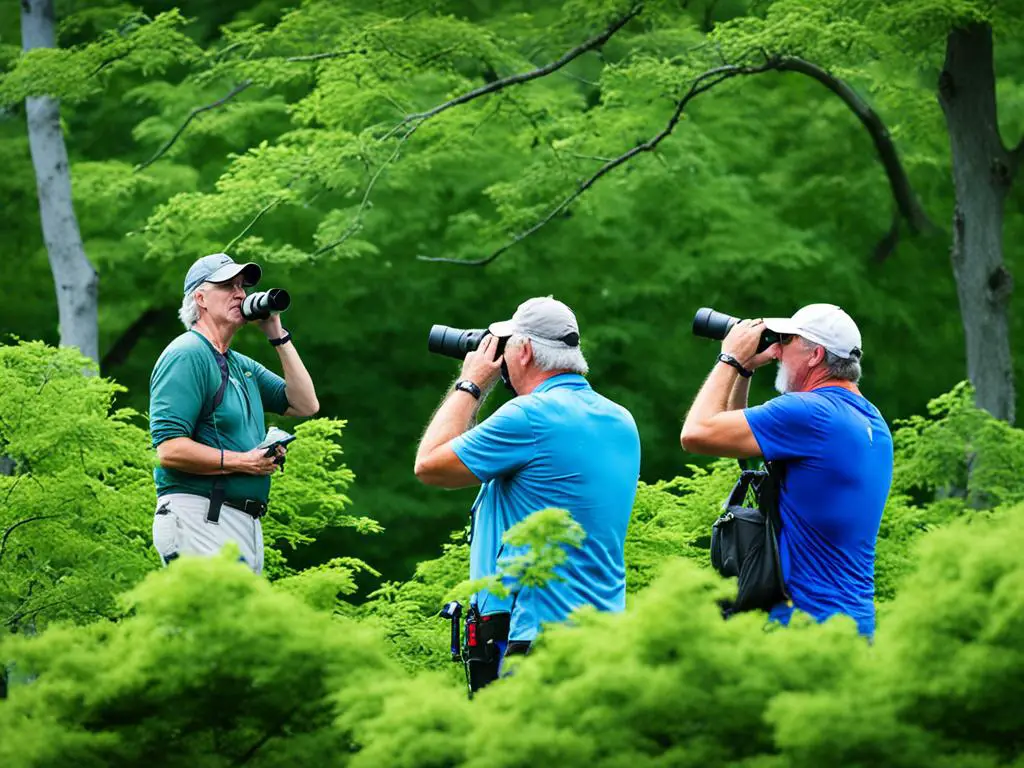
Birding in Brooklyn: Explore Prospect Park
Prospect Park in Brooklyn is a fantastic location for bird watching. With over 200 bird species passing through the park every year, it offers incredible opportunities for birders. The park is home to the nation’s first urban Audubon Center, located at the Boathouse, which provides educational exhibits and birding programs.
The Ramble, a 36-acre wild garden in the park, is particularly renowned for springtime songbird sightings. The North Woods of Central Park is another hotspot for songbirds and various owl species. Don’t miss visiting Belvedere Castle, which offers stunning views of the city and opportunities to observe hawks.
Prospect Park is a must-visit destination for bird enthusiasts in Brooklyn.
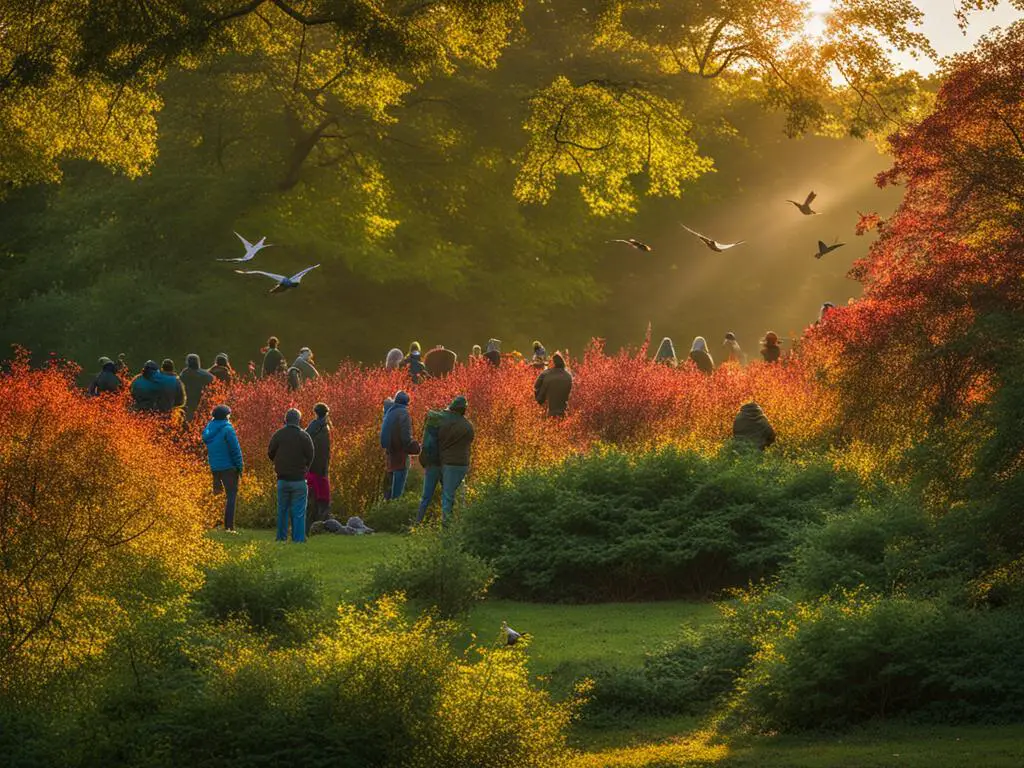
Bird Species in Prospect Park
| Bird Species | Migration Season |
|---|---|
| American Robin | Year-round |
| Blue Jay | Year-round |
| Northern Cardinal | Year-round |
| Black-capped Chickadee | Year-round |
| Diamond-backed Terrapin | Year-round |
| Ruby-throated Hummingbird | Spring and summer |
| Red-tailed Hawk | Year-round |
| Wood Duck | Year-round |
| Mallard | Year-round |
Marine Park: Brooklyn’s Birding Gem
Marine Park, Brooklyn’s largest park, is a hidden gem for bird watching. Its 798 acres of marshes and coastline offer diverse habitats for a wide variety of bird species.
Visit Gerritsen Creek, a freshwater creek that attracts myrtle warblers, Canada geese, and various species of ducks and shorebirds. The park is also in close proximity to the Jamaica Bay Wildlife Refuge, which further expands birding opportunities.
Take advantage of the Urban Park Rangers’ birding trips by canoe to White Island, a natural area within Gerritsen Creek that serves as a haven for herons and egrets.
Marine Park is a must-visit destination for birders seeking tranquility and an abundance of bird species.
Bird Species in Marine Park
| Bird Species | Habitat | Migration Patterns |
|---|---|---|
| Myrtle Warbler | Marshes, Woodlands | Long-distance Migrant |
| Canada Goose | Coastline, Grasslands | Resident, Migratory |
| Ducks | Marshes, Freshwater Creeks | Varies by Species |
| Shorebirds | Coastline, Mudflats | Migratory |
| Herons | Wetlands, Creeks | Resident, Migratory |
| Egrets | Wetlands, Creeks | Resident, Migratory |
Central Park: Birding in the Heart of Manhattan
Central Park, located in the heart of Manhattan, is a birding hotspot that offers exceptional opportunities to observe a diverse range of bird species. With approximately 230 species of birds, the park presents year-round birding possibilities for both seasoned birders and beginners.
The Ramble, a 36-acre wild garden within Central Park, is a favorite spot for bird enthusiasts, particularly during the spring migration season. As songbirds pass through the park in large numbers, this area becomes a hub of activity, providing incredible sightings and melodic bird songs.
The North Woods of Central Park is another area that birders should explore. With its varied habitats and dense vegetation, the North Woods is home to a diverse population of songbirds and owls. It offers an immersive birding experience amidst the tranquility of nature.
“Central Park is not only a green oasis in the middle of the city, but it is also a vital habitat for a wide variety of bird species,” says John Smith, a local birder and member of the Central Park Birding Club. “The park’s diverse habitats, such as woodlands, meadows, and lakes, attract a remarkable range of birds throughout the year.”
For birders eager to observe hawks, Belvedere Castle provides an excellent vantage point. Perched atop Vista Rock, this historic landmark offers breathtaking views of the park and the opportunity to spot various hawk species as they soar through the sky.
| Central Park Birding Highlights | Species | Recommended Season |
|---|---|---|
| The Ramble | Warblers, Orioles, Thrushes | Spring Migration |
| North Woods | Woodpeckers, Warblers, Owls | Year-round |
| Belvedere Castle | Hawks | Year-round |
Central Park hosts various birding events throughout the year, including guided walks and educational programs. The park also offers Discovery Kits at the castle, allowing visitors to borrow binoculars and field guides to enhance their birding experience.
If you’re passionate about bird watching or simply want to connect with nature in the heart of Manhattan, Central Park is a must-visit destination.
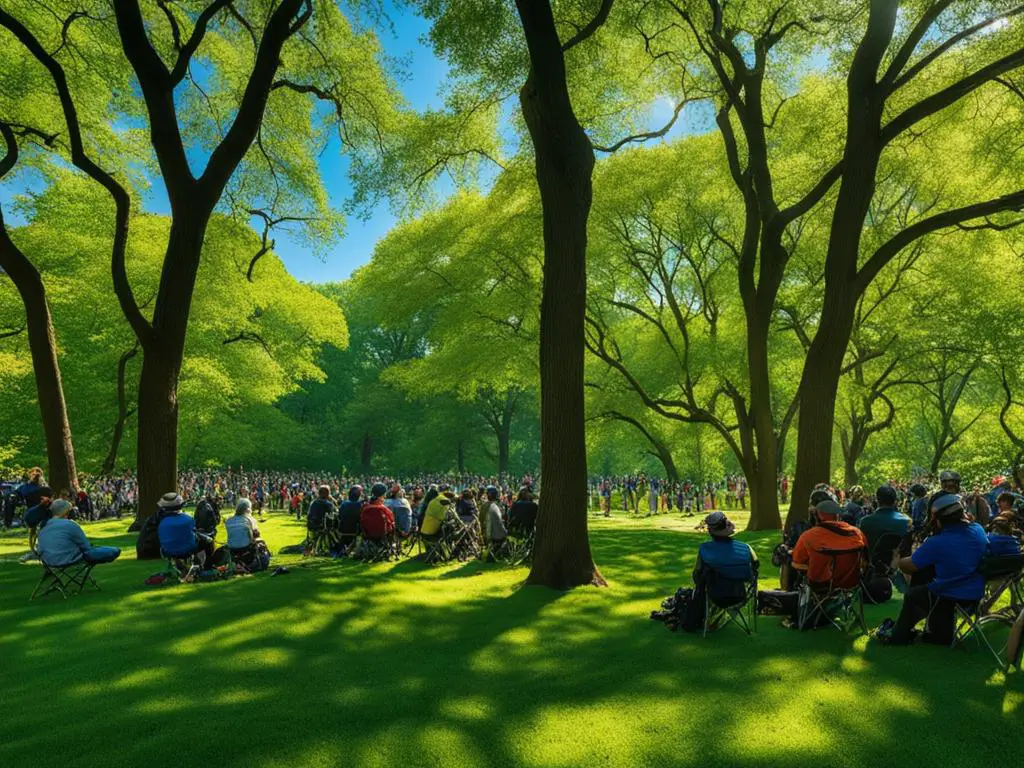
So grab your binoculars, prepare your field guide, and immerse yourself in the vibrant birding community of Central Park. Explore the different habitats, listen to the beautiful melodies of the songbirds, and be captivated by the majestic hawks soaring above. Discover the wonders of birding in one of the world’s most iconic urban parks.
Northern Manhattan Parks: A Haven for Birders
When it comes to birding in New York City, Northern Manhattan parks provide a paradise for bird enthusiasts. These parks offer diverse habitats and breathtaking views that attract a wide variety of bird species. Whether you’re an experienced birder or just starting out, Inwood Hill Park, Fort Tryon Park, Highbridge Park, and Fort Washington Park are must-visit destinations on your birding itinerary.
Inwood Hill Park: A Natural Oasis
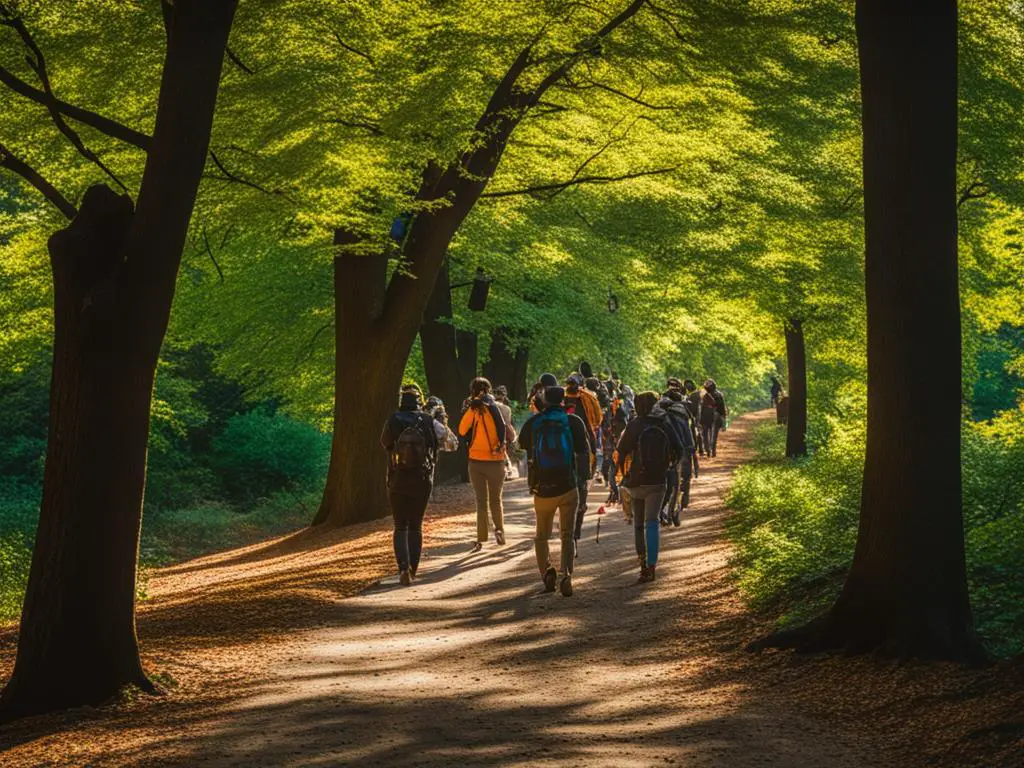
Inwood Hill Park, with its forested areas and salt marsh, is a haven for birders seeking a peaceful escape. As you explore the park’s trails and pathways, keep an eye out for various songbirds, including warblers and thrushes. Listen for the distinctive calls of belted kingfishers and keep your eyes peeled for the elusive screech owls and barred owls. Inwood Hill Park offers a tranquil and immersive birding experience in the heart of Northern Manhattan.
Fort Tryon Park: Elevated Views and Songbird Serenades
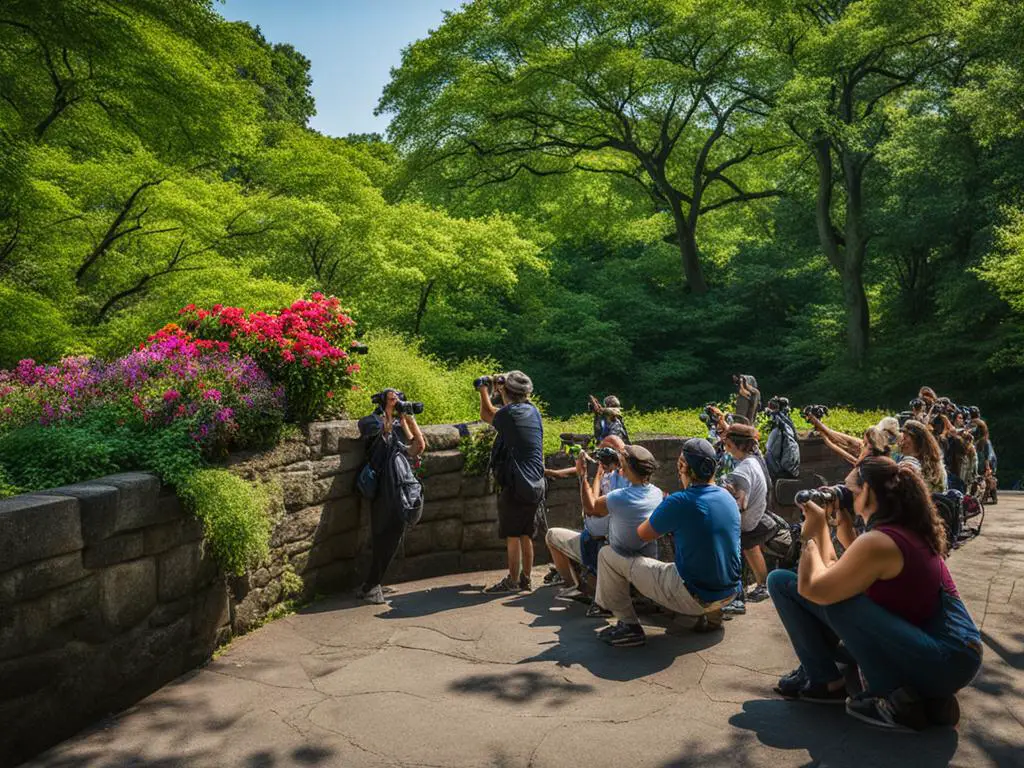
Fort Tryon Park offers an enchanting combination of elevated views and rich birdlife. From the park’s elevated location, you can enjoy sweeping vistas of the Hudson River and the Palisades while spotting a variety of bird species. The Heather Garden within Fort Tryon Park is a popular spot for songbirds, which serenade visitors with their melodic tunes during the spring and summer months. Birders will find solace and stunning bird sightings at Fort Tryon Park.
Highbridge Park: Hawk Watching at its Finest
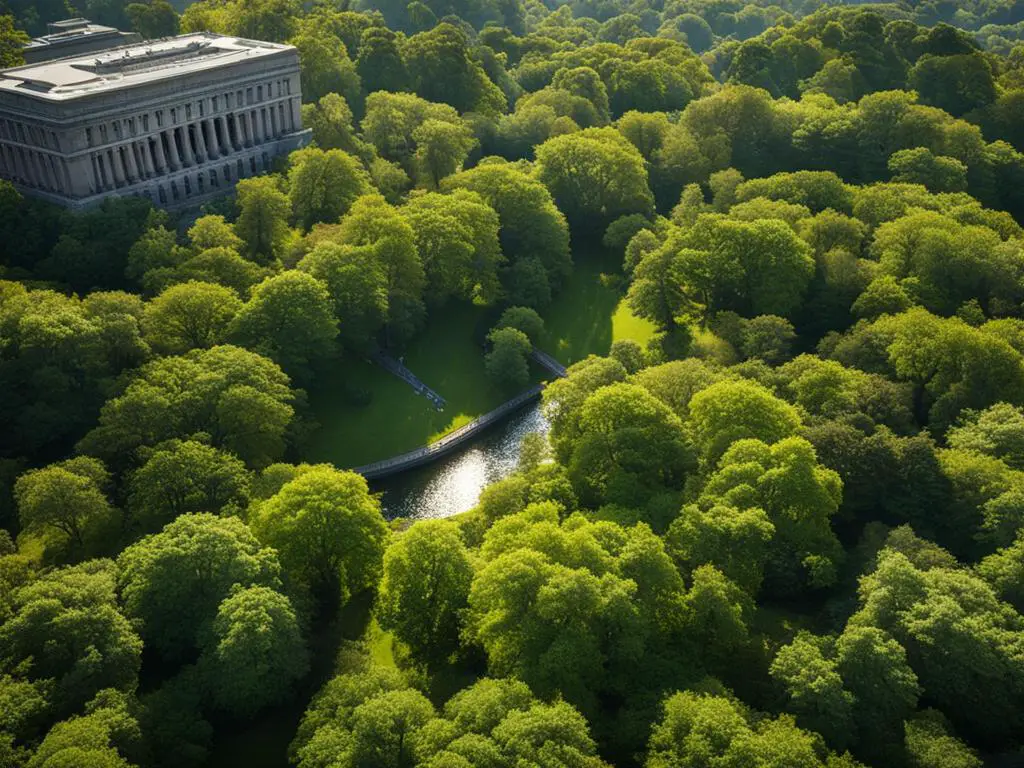
Highbridge Park, known for its winding trails and oak-hickory forests, provides excellent opportunities for hawk watching. During the spring and fall migrations, this park becomes a hotspot for hawk enthusiasts. Find a comfortable spot along the trails and keep your eyes on the skies as you witness the awe-inspiring sight of hawks soaring through the air. Highbridge Park offers a unique and thrilling birding experience that will leave you in awe of these majestic birds of prey.
Fort Washington Park: Peregrine Falcons and Scenic Beauty
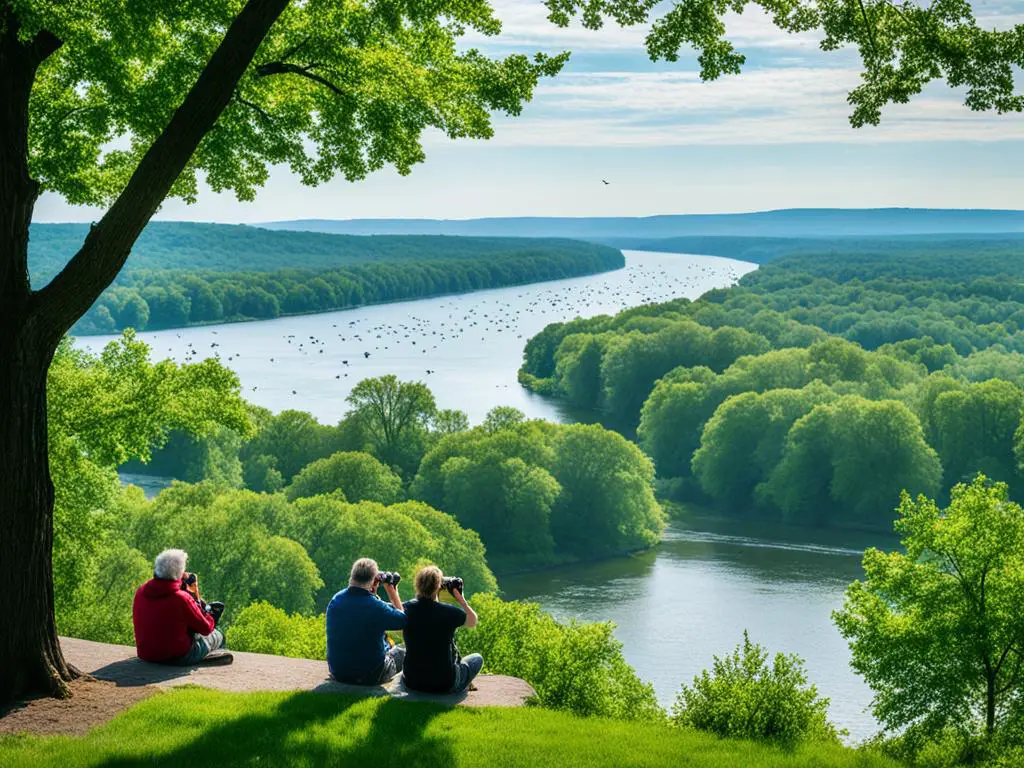
Fort Washington Park, located under the iconic George Washington Bridge, is a hidden gem for birding in Northern Manhattan. This park is particularly known for its population of peregrine falcons, which can sometimes be spotted perched near the bridge. Take a leisurely stroll along the park’s paths, enjoying the scenic beauty of the riverfront while keeping an eye out for these majestic falcons. Fort Washington Park offers a captivating blend of avian wonders and stunning vistas.
| Park | Bird Species | Highlights |
|---|---|---|
| Inwood Hill Park | Songbirds, belted kingfishers, screech owls, barred owls | Forested areas, salt marshes for diverse bird sightings |
| Fort Tryon Park | Songbirds, various species | Elevated views of the Hudson River and Palisades |
| Highbridge Park | Hawks and other raptors | Winding trails, oak-hickory forests |
| Fort Washington Park | Peregrine falcons | Spectacular view under the George Washington Bridge |
Embrace the natural beauty of Northern Manhattan as you immerse yourself in the world of birds. Inwood Hill Park, Fort Tryon Park, Highbridge Park, and Fort Washington Park await you with their splendor and richness of birdlife. Visit these parks and discover the wonders of birding in Northern Manhattan.
Birding Seasons in New York City: When To Bird
In New York City, the best time for birding varies throughout the year. Spring and fall migrations are particularly exciting, as millions of migratory birds pass through the city’s parks.
“Spring migration is most active from March to May, with peak warbler migration in late April through mid-May.”
During spring migration, the city becomes a vibrant hub for bird watchers, offering opportunities to spot a wide variety of species. As the weather warms up, bird populations increase, and you can witness the beauty of warblers in their colorful plumage.
“Fall migration extends from mid-August to October, with peak numbers of songbirds in mid-September to mid-October.”
As summer transitions to fall, millions of birds embark on their southward journey, making New York City a stopover for rest and refueling. The city’s parks become a bustling spectacle of songbirds, providing fantastic birding experiences.
Summer is another great time for birding, especially if you’re interested in observing nesting birds. The larger parks offer suitable habitats for many bird species to breed and raise their young.
In winter, you have the opportunity to spot owls and wintering waterfowl in the city’s parks. With a bit of luck and patience, you might glimpse these elusive creatures amid the serene winter landscapes.
“The optimal time of day for birding is typically between dawn and 11 am, as birds are most active during this period.”
Early mornings are prime time for bird watching, as birds tend to be more active and vocal during this period. You can enjoy the chorus of songs and observe a wide range of bird behaviors as they forage for food and defend their territories.
“Different weather conditions can also affect bird activity, with warm and sunny days being ideal in spring and overcast or slightly rainy days offering good birding opportunities.”
Weather plays a significant role in bird behavior and activity. Clear, sunny days in spring often coincide with bird migration, providing excellent visibility and opportunities to witness large flocks of birds in transit. Overcast or slightly rainy days can be ideal for birding, as birds may be more active and visible, seeking food and shelter.
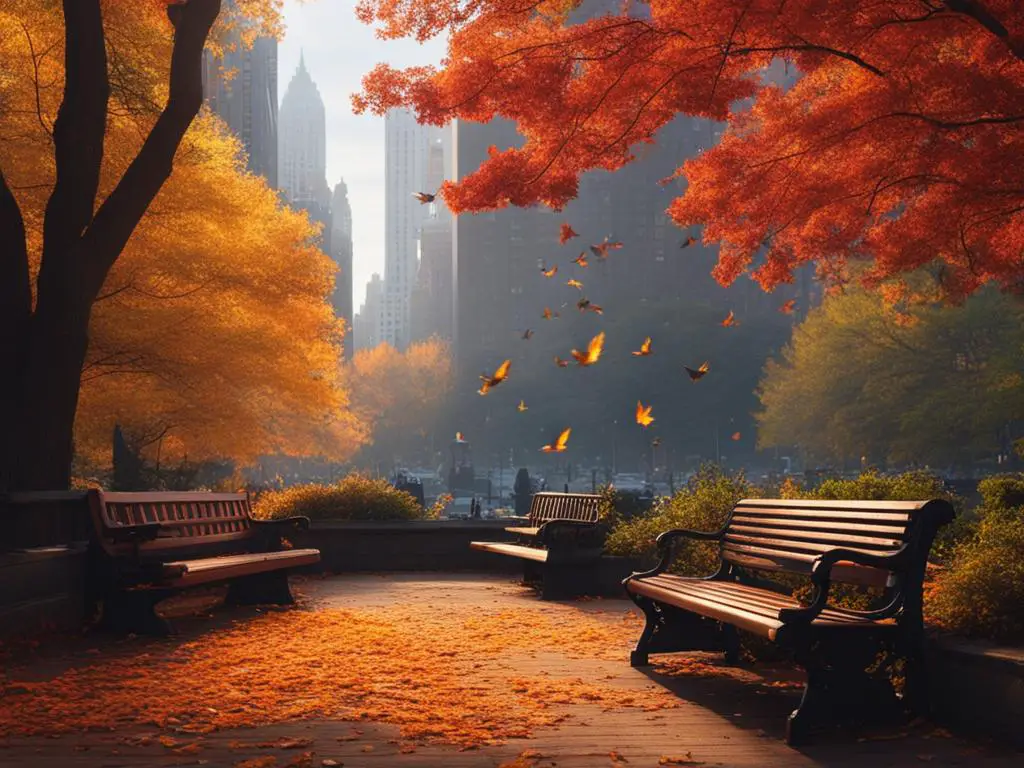
Understanding the different birding seasons, considering the time of day, and keeping an eye on weather conditions can greatly enhance your birding experiences in New York City. Whether you’re a seasoned bird watcher or a beginner, the city’s parks offer something extraordinary for every bird lover.
The New York State Birding Trail: Enhancing Access to Nature
The New York State Birding Trail is a collaboration between the New York State Department of Environmental Conservation (DEC) and various partners, including the Office of Parks, Recreation and Historic Preservation. This trail aims to enhance access to nature for all visitors, regardless of age, ability, identity, or background.
The trail consists of 344 birding locations across the state, offering a wide variety of quality birding experiences. The addition of 12 new locations brings even more diversity and opportunities for birding enthusiasts.
The trail includes both publicly and privately managed sites, ensuring an inclusive experience for everyone. Visitors can access these locations by car or public transportation, making birding accessible and affordable.
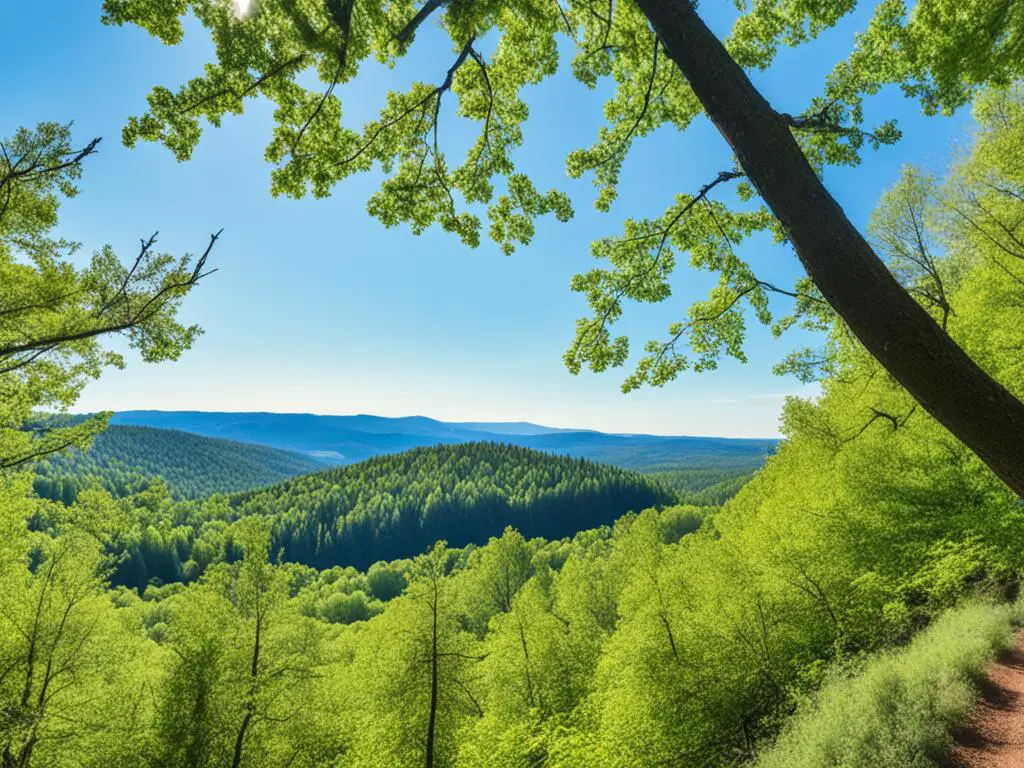
The New York State Birding Trail is an excellent resource for birders looking to explore the state’s diverse bird populations and natural settings.
| Key Features | Benefits |
|---|---|
| 344 birding locations across New York | Provides a wide variety of birding experiences |
| Includes both publicly and privately managed sites | Ensures inclusivity and accessibility for all visitors |
| Accessible by car or public transportation | Makes birding affordable and convenient |
| Addition of 12 new locations | Increases diversity and opportunities for birding |
Conclusion
New York offers a wealth of birding opportunities for enthusiasts of all levels. Whether you’re in the Bronx, Brooklyn, Manhattan, or on Long Island, there are numerous hotspots and trails where you can observe a wide variety of bird species. Van Cortlandt Park, Pelham Bay Park, Prospect Park, Marine Park, Central Park, and the parks of Northern Manhattan are just some of the destinations where you can experience the beauty of bird watching in the city.
But the birding adventure doesn’t stop there. The New York State Birding Trail opens up even more possibilities, with its 344 birding locations across the state. This trail, a collaboration between the New York State Department of Environmental Conservation and other partners, offers diverse and inclusive birding experiences for all visitors. Whether you’re a seasoned birder or a beginner, New York has something to offer.
So grab your binoculars, pack your camera, and get ready to explore the awe-inspiring world of birds in the vibrant landscapes of New York. Whether you’re seeking the best birding spots, year-round birding opportunities, or the chance to be part of the New York State Birding Trail, New York won’t disappoint. Start your birding adventure today and discover why birding in New York is truly an unforgettable experience.
FAQ
What are some of the best birding spots in New York?
Some of the best birding spots in New York include Van Cortlandt Park, Pelham Bay Park, Prospect Park, Marine Park, Central Park, and Northern Manhattan parks. These locations offer diverse habitats and a wide variety of bird species for enthusiasts to observe.
What bird species can I expect to see in Van Cortlandt Park?
Van Cortlandt Park is home to approximately 230 species of birds. Some of the species you may see include mallard and wood ducks, red-winged blackbirds, great egrets, hawks, herons, owls, woodpeckers, warblers, and wood thrushes.
What can I expect to see in Pelham Bay Park?
Pelham Bay Park is known for its populations of owls and ospreys. You can also spot migratory birds such as black-crowned night herons, little blue herons, glossy ibises, and ring-necked pheasants. The park offers a variety of grassland and coastal habitats.
What bird species can I observe in Prospect Park?
Prospect Park is home to over 200 bird species. The park is renowned for its springtime songbird sightings in the Ramble. The North Woods of Central Park is also a hotspot for songbirds and various owl species. Hawks can often be seen from Belvedere Castle.
What can I expect to find in Marine Park?
Marine Park offers diverse habitats, including marshes and coastline, attracting a wide variety of bird species. You may see myrtle warblers, Canada geese, ducks, shorebirds, herons, egrets, and more. The park is also close to the Jamaica Bay Wildlife Refuge, which expands birding opportunities.
What birding opportunities does Central Park offer?
Central Park is a hot spot for birding in the heart of Manhattan. The park boasts approximately 230 species of birds. The Ramble is well-known for springtime songbird sightings, while the North Woods is home to diverse songbird and owl populations. Belvedere Castle offers excellent views for observing hawks.
What parks in Northern Manhattan are ideal for birding?
Inwood Hill Park, Fort Tryon Park, Highbridge Park, and Fort Washington Park in Northern Manhattan offer exceptional birding opportunities. These parks feature forested areas, salt marshes, elevated views, and winding trails that attract a variety of bird species including songbirds, kingfishers, owls, and falcons.
When is the best time for birding in New York City?
The best time for birding in New York City varies throughout the year. Spring and fall migrations are particularly exciting, with peak warbler migration in late April through mid-May and peak numbers of songbirds in mid-September to mid-October. Summer is great for observing nesting birds, while winter brings the possibility of spotting owls and wintering waterfowl.
What is the New York State Birding Trail?
The New York State Birding Trail is a collaboration between the New York State Department of Environmental Conservation (DEC) and various partners. This trail consists of 344 birding locations across the state, both publicly and privately managed. It aims to enhance access to nature for all visitors, offering diverse and inclusive birding experiences.
What are some of the key advantages of the New York State Birding Trail?
The New York State Birding Trail provides a wide variety of quality birding experiences across the state. The trail includes both publicly and privately managed sites, making it inclusive and accessible to all. Visitors can access these locations by car or public transportation, facilitating an affordable and convenient birding experience.
If you enjoyed reading this article, please check out
If you enjoyed reading this article, please check out When and Where to Go Birding in New Hampshire

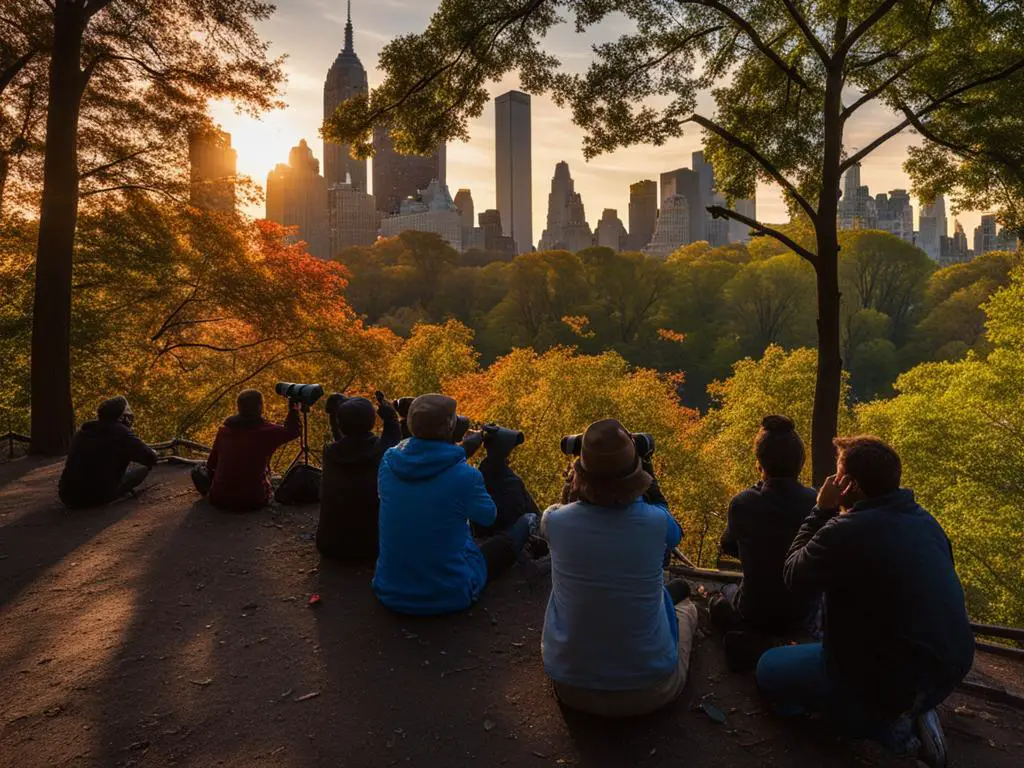
Comments are closed